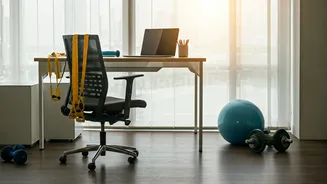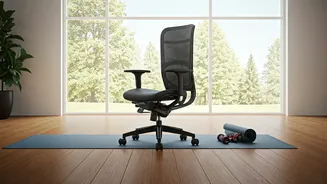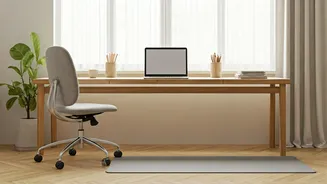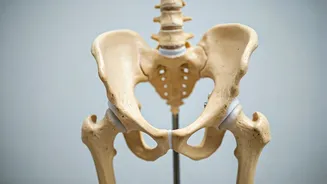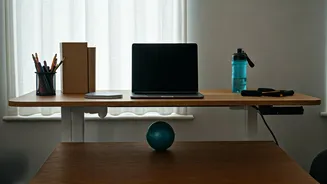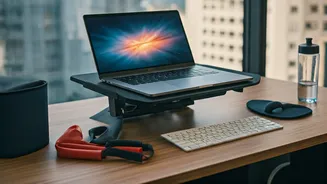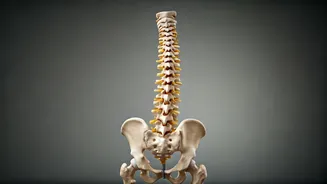Neck Rolls and Tilts
Sitting for extended periods often results in neck stiffness. Counteracting this, neck rolls and tilts offer immediate relief. Begin by gently lowering
your chin towards your chest, then slowly rolling your head to one shoulder, keeping your neck relaxed. Continue to the back, then to the other shoulder, completing the circle. Perform this movement slowly, focusing on stretching the neck muscles. For neck tilts, gently bring your ear towards your shoulder, holding for a few seconds before switching sides. These movements can be performed discreetly, and they directly address the tension often accumulated from desk work, ensuring improved flexibility and decreased discomfort.
Shoulder Blade Squeezes
Shoulder blade squeezes are essential for countering poor posture and preventing back pain. Throughout the day, especially after prolonged sitting, incorporate this exercise to realign your shoulders. To perform this, sit upright and squeeze your shoulder blades together, as if you're trying to pinch a pencil between them. Hold this position for a few seconds, then relax. Repeat these squeezes several times to strengthen the muscles supporting your upper back. This targeted exercise helps open up the chest, which is often compressed when seated for hours, and promotes better posture, reducing the strain on the upper back and shoulders.
Wrist and Hand Stretches
Desk work often involves repetitive movements that strain the wrists and hands. Counteracting this requires targeted stretches throughout the day. Start by extending one arm in front of you, palm facing down. Using your other hand, gently pull your fingers back towards your body, stretching the underside of your forearm. Hold this stretch for several seconds, then switch hands. You can also make a fist and gently rotate your wrists in both directions to improve mobility. These simple exercises are crucial for preventing carpal tunnel syndrome and other repetitive strain injuries, particularly beneficial for those who spend a lot of time typing or using a mouse.
Torso Twists
Torso twists can relieve spinal stiffness and improve core strength. While seated, keep your feet flat on the floor and your back straight. Place your hands on your desk or chair for support. Gently twist your torso to one side as far as comfortable, holding for a few seconds, then return to the center. Repeat this on the opposite side. These twists gently stretch the muscles of the back and abdomen, improving spinal flexibility. They also encourage better circulation and can help alleviate back pain. Performing torso twists frequently counters the effects of prolonged sitting and promotes better posture and overall core health.
Desk Push-Ups
Desk push-ups provide a quick way to engage chest, triceps, and shoulder muscles without needing a lot of space. Place your hands shoulder-width apart on the edge of your desk. Step back a few feet, leaning your body at an angle towards the desk. Lower your chest towards the desk by bending your elbows, then push back up. Aim for a few repetitions to begin with, gradually increasing as your strength improves. Desk push-ups provide a straightforward way to incorporate strength training into the work routine, improving upper body strength and reducing the effects of a sedentary lifestyle. This can be very beneficial for those working from home or in offices.
Leg Extensions
Leg extensions help to counteract the effects of sitting by improving circulation and strengthening leg muscles. While seated, extend one leg straight out in front of you, keeping your foot flexed. Hold this position for a few seconds, then lower your leg. Repeat with the other leg. You can enhance the exercise by slightly tensing your quadriceps muscles as you extend your legs. This simple exercise boosts circulation in the lower body and alleviates leg stiffness, promoting overall leg strength and flexibility. They are easy to do at any point during your day, making them convenient for office or home work environments.
Ankle Circles and Pumps
Ankle circles and pumps promote blood flow in the lower legs and help to prevent swelling and stiffness. Sit with your feet flat on the floor or slightly elevated. Slowly rotate your ankles in a circular motion, both clockwise and counterclockwise. Then, point your toes up, and then down, performing ankle pumps. These exercises are particularly useful for those who spend extended periods sitting. They boost circulation, alleviate potential swelling, and maintain ankle flexibility. Simple, yet effective, these exercises can significantly enhance comfort and well-being, especially for those with long work hours.


